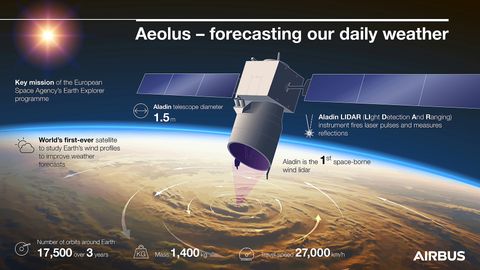Owned and operated by the European Space Agency (ESA), Aeolus was the first satellite capable of performing global wind-component-profile observations on a daily basis in near real-time.
As a demonstrator satellite, it was developed to prove that new technologies can profile the Earth’s winds to understand how wind, pressure, temperature and humidity are interconnected – enhancing climate research and weather forecasting.
Aeolus was equipped with an innovative Airbus-designed LIDAR (Light Detection And Ranging) instrument called Aladin, which used the Doppler effect to determine wind speed. Airbus is the only company to fly such an instrument in space, proving its capability to deliver such systems based on 20 years of expertise.
On 28 July 2023 Aeolus bid its farewell, burning up as it reentered the Earth’s atmosphere. Well-known for its pioneering monitoring of wind conditions on a global scale, Aeolus will also enter the history books as the first assisted satellite reentry, initiated by Airbus.
From strength to strength
Since its launch, Aeolus consistently provided high quality data and went above and beyond the original mission. Providing missing wind measurements that were regularly provided by airliners prior to the COVID-19-caused reduction in air travel, Aeolus was deemed so valuable that the satellite’s information has been adopted for daily weather forecasting.
In January 2020, the UK-based European Centre for Medium-Range Weather Forecasts (ECMWF) started using wind data from the Aeolus satellite, even taking into account the mission’s experimental nature – a testament to the impact its data has on weather forecasting. Aeolus is now being distributed to forecasting services and scientific users less than three hours after collection from space.
Indeed, the volume of data also clearly sets it apart, since this one satellite was delivering more wind data than all existing ground-based measuring systems.

Aeolus-2: the future of daily LIDAR meteorology
The fact that Aeolus data was used as part of the operational weather forecasting flow demonstrates its quality and reliability. Built as a one-off research mission, Aeolus truly exceeded all expectations – a testament to our engineers’ skill and determination in developing this new technology. Its success also paves the way for a possible future fleet of Doppler wind Lidar satellites in space.
The proposed follow-on mission, Aeolus-2, is set to be operational for much longer (five to seven years), and will feature improved performance with the technology becoming more robust, with reduced error on wind speed measurements, and better resolution – meaning it will have an even more significant impact on global weather forecasting than its predecessor.


For other topics on how Airbus is committed to using space for the benefit of humanity, visit the#NextSpace page on Airbus.com
